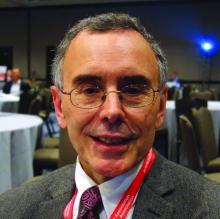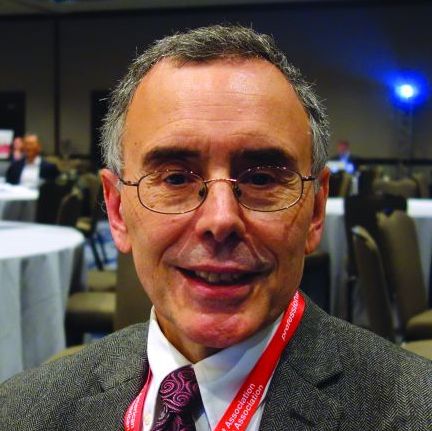User login
SAN FRANCISCO – In just 6 months, a commonsense quality improvement program increased the rate of blood pressure control from 66% to 75% among 21,035 hypertensive patients at 16 primary care clinics in northwestern South Carolina.
The American Medical Association collaborated with the Care Coordination Institute in Greenville, S.C., to develop the program, dubbed “MAP,” which stands for measuring blood pressure accurately; acting rapidly to manage uncontrolled blood pressure; and partnering with patients to promote blood pressure self-management.
With the success in South Carolina, it’s likely the program will be rolled out to other parts of the country, Dr. Egan said at the joint scientific sessions of AHA Council on Hypertension, AHA Council on Kidney in Cardiovascular Disease, and American Society of Hypertension
Twelve of the 16 practices had significant increases in BP control. In patients uncontrolled at baseline, mean BP fell from 149/85 mm Hg to 139/80 mm Hg. In controlled patients, BP fell about 10/5 mm Hg. The findings were statistically significant.
To reduce white coat hypertension and improve BP accuracy, patients who had an initial, attended BP at or above 140/90 mm Hg were put in a room by themselves for 5 minutes for three automated BP measurements, which were then averaged. Staff made sure patients were positioned properly and had the correctly sized cuff on their arm, among other measures. A program facilitator was onsite to help.
Patients who had BPs at or above 140/90 mm Hg when they were left alone were switched to drugs that have been proven to help. For white patients younger than 55 years, that meant a renin-angiotensin system blocker first and a calcium channel blocker second. For older African American patients, the calcium channel blocker came first. A diuretic was added if needed as a third step, and then spironolactone as a fourth. “That was basically the regimen in the absence of compelling indications for other agents,” Dr. Egan said.
Single-pill combinations were encouraged to help with compliance. The investigators also worked with nearby pharmacies to use generic drugs to keep costs low, and to ensure that patients could pick up all their prescriptions at one visit. Many of the patients had multiple chronic conditions and were on a half dozen or more drugs. Picking them all up at one pharmacy visit has been shown to improve adherence.
There was follow-up every 2 weeks for patients with stage 2 hypertension, at least by phone. Stage 1 patients had monthly follow-ups. Lifestyle changes were encouraged, as well as home BP monitoring. The clinics were given a few home monitors to send home with patients, and patients reported their results. If BP was elevated at home, patients were contacted and advised before their next visit.
They were also given a cookbook that matched the DASH diet with the southern palate. “We tried to make it taste good and not cost more,” Dr. Egan said. “It’s been quite popular for our patients who are willing to give it a try. It’s free on our website.”
With the intervention, “not only did [patients] take their new medications, but they also were probably taking previous medications more reliably,” he said.
It’s likely that the program reduced hypertension comorbidities, Dr. Egan noted, but there was no cost-benefit analysis.
There was no pharmaceutical industry funding. Dr. Egan disclosed research support from Boehringer.
SAN FRANCISCO – In just 6 months, a commonsense quality improvement program increased the rate of blood pressure control from 66% to 75% among 21,035 hypertensive patients at 16 primary care clinics in northwestern South Carolina.
The American Medical Association collaborated with the Care Coordination Institute in Greenville, S.C., to develop the program, dubbed “MAP,” which stands for measuring blood pressure accurately; acting rapidly to manage uncontrolled blood pressure; and partnering with patients to promote blood pressure self-management.
With the success in South Carolina, it’s likely the program will be rolled out to other parts of the country, Dr. Egan said at the joint scientific sessions of AHA Council on Hypertension, AHA Council on Kidney in Cardiovascular Disease, and American Society of Hypertension
Twelve of the 16 practices had significant increases in BP control. In patients uncontrolled at baseline, mean BP fell from 149/85 mm Hg to 139/80 mm Hg. In controlled patients, BP fell about 10/5 mm Hg. The findings were statistically significant.
To reduce white coat hypertension and improve BP accuracy, patients who had an initial, attended BP at or above 140/90 mm Hg were put in a room by themselves for 5 minutes for three automated BP measurements, which were then averaged. Staff made sure patients were positioned properly and had the correctly sized cuff on their arm, among other measures. A program facilitator was onsite to help.
Patients who had BPs at or above 140/90 mm Hg when they were left alone were switched to drugs that have been proven to help. For white patients younger than 55 years, that meant a renin-angiotensin system blocker first and a calcium channel blocker second. For older African American patients, the calcium channel blocker came first. A diuretic was added if needed as a third step, and then spironolactone as a fourth. “That was basically the regimen in the absence of compelling indications for other agents,” Dr. Egan said.
Single-pill combinations were encouraged to help with compliance. The investigators also worked with nearby pharmacies to use generic drugs to keep costs low, and to ensure that patients could pick up all their prescriptions at one visit. Many of the patients had multiple chronic conditions and were on a half dozen or more drugs. Picking them all up at one pharmacy visit has been shown to improve adherence.
There was follow-up every 2 weeks for patients with stage 2 hypertension, at least by phone. Stage 1 patients had monthly follow-ups. Lifestyle changes were encouraged, as well as home BP monitoring. The clinics were given a few home monitors to send home with patients, and patients reported their results. If BP was elevated at home, patients were contacted and advised before their next visit.
They were also given a cookbook that matched the DASH diet with the southern palate. “We tried to make it taste good and not cost more,” Dr. Egan said. “It’s been quite popular for our patients who are willing to give it a try. It’s free on our website.”
With the intervention, “not only did [patients] take their new medications, but they also were probably taking previous medications more reliably,” he said.
It’s likely that the program reduced hypertension comorbidities, Dr. Egan noted, but there was no cost-benefit analysis.
There was no pharmaceutical industry funding. Dr. Egan disclosed research support from Boehringer.
SAN FRANCISCO – In just 6 months, a commonsense quality improvement program increased the rate of blood pressure control from 66% to 75% among 21,035 hypertensive patients at 16 primary care clinics in northwestern South Carolina.
The American Medical Association collaborated with the Care Coordination Institute in Greenville, S.C., to develop the program, dubbed “MAP,” which stands for measuring blood pressure accurately; acting rapidly to manage uncontrolled blood pressure; and partnering with patients to promote blood pressure self-management.
With the success in South Carolina, it’s likely the program will be rolled out to other parts of the country, Dr. Egan said at the joint scientific sessions of AHA Council on Hypertension, AHA Council on Kidney in Cardiovascular Disease, and American Society of Hypertension
Twelve of the 16 practices had significant increases in BP control. In patients uncontrolled at baseline, mean BP fell from 149/85 mm Hg to 139/80 mm Hg. In controlled patients, BP fell about 10/5 mm Hg. The findings were statistically significant.
To reduce white coat hypertension and improve BP accuracy, patients who had an initial, attended BP at or above 140/90 mm Hg were put in a room by themselves for 5 minutes for three automated BP measurements, which were then averaged. Staff made sure patients were positioned properly and had the correctly sized cuff on their arm, among other measures. A program facilitator was onsite to help.
Patients who had BPs at or above 140/90 mm Hg when they were left alone were switched to drugs that have been proven to help. For white patients younger than 55 years, that meant a renin-angiotensin system blocker first and a calcium channel blocker second. For older African American patients, the calcium channel blocker came first. A diuretic was added if needed as a third step, and then spironolactone as a fourth. “That was basically the regimen in the absence of compelling indications for other agents,” Dr. Egan said.
Single-pill combinations were encouraged to help with compliance. The investigators also worked with nearby pharmacies to use generic drugs to keep costs low, and to ensure that patients could pick up all their prescriptions at one visit. Many of the patients had multiple chronic conditions and were on a half dozen or more drugs. Picking them all up at one pharmacy visit has been shown to improve adherence.
There was follow-up every 2 weeks for patients with stage 2 hypertension, at least by phone. Stage 1 patients had monthly follow-ups. Lifestyle changes were encouraged, as well as home BP monitoring. The clinics were given a few home monitors to send home with patients, and patients reported their results. If BP was elevated at home, patients were contacted and advised before their next visit.
They were also given a cookbook that matched the DASH diet with the southern palate. “We tried to make it taste good and not cost more,” Dr. Egan said. “It’s been quite popular for our patients who are willing to give it a try. It’s free on our website.”
With the intervention, “not only did [patients] take their new medications, but they also were probably taking previous medications more reliably,” he said.
It’s likely that the program reduced hypertension comorbidities, Dr. Egan noted, but there was no cost-benefit analysis.
There was no pharmaceutical industry funding. Dr. Egan disclosed research support from Boehringer.
AT JOINT HYPERTENSION 2017

